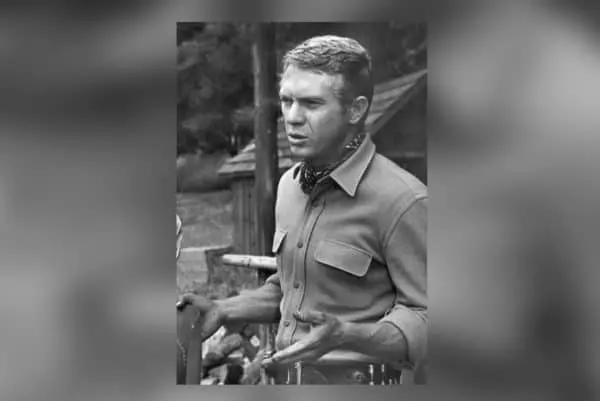
Steve McQueen is an iconic actor of the 1960s and 1970s. He is also one of the most famous victims of mesothelioma.
McQueen was a rising star in the 1960s. He acted in some of the most popular movies of the time, including The Thomas Crown Affair, The Cincinnati Kid and The Great Escape. By the early 1970s, he was one of the highest-paid actors in America.
Sadly, McQueen’s acting career was cut short by an unexpected pleural mesothelioma diagnosis. It is believed that McQueen was exposed to asbestos while serving in the United States Marine Corps in the late 1940s. In 1980, McQueen died of mesothelioma at the age of 50.
Steve McQueen Exposed to Asbestos
McQueen served in the U.S. Marine Corps from 1947 to 1950. During his service, McQueen spent time working on board naval ships and in shipyards. It is likely he was exposed to asbestos during this time in the military.
Service aboard military ships posed some of the greatest threats of asbestos exposure. Marines, sailors and airmen made contact with the deadly mineral in nearly every area of these ships, including:
- Boiler rooms
- Engine rooms
- Galleys
- Mess halls
- Navigational rooms
- Sleeping quarters
- Storage rooms
Living and working in tight quarters with poor ventilation meant any disturbed asbestos fibers would become more concentrated in the air. The microscopic fibers can easily be inhaled or ingested and eventually lodge themselves in the lining of organs. Over time, asbestos fibers can create scarring and inflammation. This can lead to the development of mesothelioma tumors and other types of cancer.
Although McQueen was honorably discharged from the U.S. Marine Corps in 1950, his exposure to asbestos likely did not end there.
Asbestos Use in Hollywood
Asbestos was used heavily in Hollywood. In addition to being inexpensive, its durability and fire resistance made it desirable for use in a wide variety of products. Hollywood even likened its appearance to snow. Individuals believed because of its heat-resistant properties, asbestos would be a safer alternative to other fake snow products. Asbestos was widely used on movie sets, especially for special effects and stunts.
On set and in his own free time, McQueen loved to race cars and motorcycles. He’d wear a flame-retardant suit while he raced for stunts or pleasure. These suits often contained asbestos. Also, many brake systems, gaskets and other high-friction car components had asbestos in them.
Steve McQueen’s Mesothelioma Diagnosis
It can take anywhere from 10 to 50 years after exposure for mesothelioma symptoms to present. In 1978, McQueen first started noticing a persistent cough, nearly 30 years after he entered military service. Soon, he was having difficulty catching his breath.
The ambiguity of the symptoms and the latency period after exposure make it difficult for doctors to correctly diagnose mesothelioma. Oftentimes, mesothelioma isn’t properly diagnosed until it has already advanced to a later stage.
About a year after his symptoms first became noticeable, McQueen received a diagnosis. In December 1979, he was diagnosed with pleural mesothelioma. Pleural mesothelioma affects the lining of the lungs. On average, pleural mesothelioma patients survive about 18 months after diagnosis.
McQueen’s doctors in the United States explained his cancer was inoperable, but they started radiation and chemotherapy to see if they could shrink the tumors. When the doctors told him his cancer was incurable, McQueen decided to seek help elsewhere.
McQueen Seeks Alternative Cancer Treatment
McQueen reached out to Dr. William Kelly. Dr. Kelly was not a practicing oncologist. In fact, Dr. Kelly’s medical license was in dentistry.
However, Dr. Kelly made claims about a cancer treatment that could not only cure cancer but help patients with a wide variety of diseases. In his desperation, McQueen hoped this radical treatment would work for his mesothelioma.
Many scientists regarded Dr. Kelly’s methods as quackery. He followed his own version of Gerson Therapy. This treatment was developed by physician Max Gerson to help patients who had migraines. He later adapted it as a cancer treatment.
Dr. Kelly’s spin on Gerson Therapy was based on the belief that all cancers stem from a lack of a pancreatic enzyme. This method of treatment centered around unorthodox methods, including:
- Coffee enemas
- Frequent shampooing of the body
- High daily intake of vitamins and minerals
- Strict diet
The treatment also included a daily dose of laetrile, a cancer drug created from the pits of apricots. The drug was never approved by the U.S. Food & Drug Administration (FDA). The National Cancer Institute (NCI) described its use as ineffective and dangerous. In later studies, it was shown this type of therapy actually worsened the patient’s quality of life.
As McQueen sought out this controversial treatment in Mexico, he struggled to keep the news of his diagnosis private. Initially, he only told close family and friends. But in March 1980, the National Enquirer broke the news of his “heroic battle” with cancer.
McQueen did not speak publicly about his diagnosis until his new doctors claimed he was improving.
“Mexico is showing the world a new way of fighting cancer through nonspecific metabolic therapies. Thank you for helping to save my life.”
– Steve McQueen, Radio broadcast
Steve McQueen’s Death
McQueen’s supposed recovery was short-lived. Although his American doctors previously warned McQueen that his heart wasn’t strong enough for surgery, his new doctors operated anyway. The surgery itself went smoothly. The doctors removed some tumors from his neck. But, McQueen died from cardiac arrest the next day. He was 50 years old.
Mesothelioma is a rare, deadly disease. At the time McQueen was diagnosed, mesothelioma was not well studied. Today, there are more emerging treatment options available for many patients. Researchers have made progress on promising treatment and diagnostic techniques. Hopefully, current and future patients will have a better chance of beating the odds.




